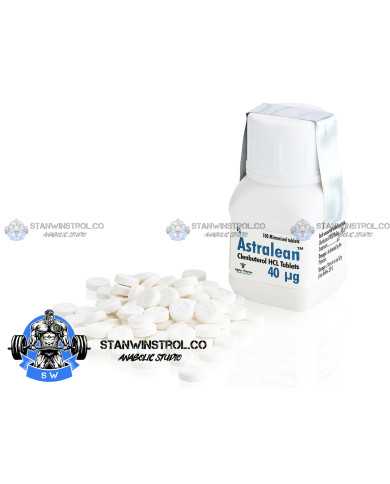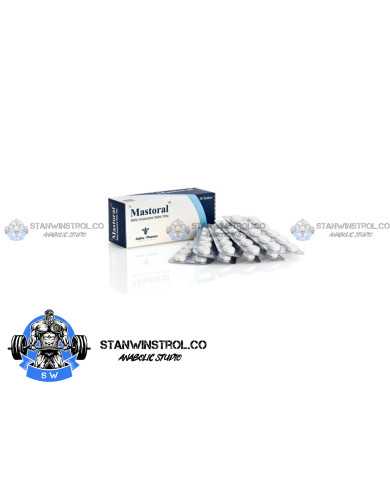CLENBUTEROL HISTORY AND OVERVIEW
Clenbuterol is not an anabolic steroid, but rather a stimulant that belongs to a classification of compounds known as sympathomimetics. This classification (or ‘family’) contains other compounds that the average person might be more familiar with, such as: caffeine, ephedrine, albuterol, amphetamines, cocaine, and many others. It is indeed quite a broad drug category, and each of the compounds in this family are related to each other, and more or less carry many similarities and operate in a similar manner through similar pathways. Clenbuterol’s effect on the nervous system involves its interaction with adrenoreceptors, which are located in many different tissues and cell types in the body. When Clenbuterol binds to these adrenoreceptors, different effects in different tissue types (depending on the tissues stimulated) will manifest. One effect in particular that we are concerned with is Clenbuterol’s effect in adipose (fat) tissue.
There are two different adrenoreceptors in the body – alpha and beta receptors – and within those two different types, there are 9 subtypes. For example, alpha-1, alpha 2, beta-1, beta-2 receptors, etc. The difference between Clenbuterol and other compounds in the stimulant family lie in their different capabilities to stimulate different subtypes, multiple subtypes, or focus on one subtype. Clenbuterol in particular I known for its very strong and almost exclusive stimulation of the beta-2 adrenoreceptors, and therefore this is why Clenbuterol is commonly referred to as a beta-2 receptor agonist. It is within fat tissue that, when beta-2 receptors are stimulated by Clenbuterol, initiate lipolysis (the breakdown of fat into free fatty acids). It has gained plenty of popularity among just bodybuilders and athletes because of this, but among entertainment celebrities, and by proxy, common people looking to drop a few pounds of fat.
Clenbuterol’s original use as a medicine in the prescription drug market was (and still currently is) as a bronchodilator in the treatment of asthma. It is most frequently administered in this manner in asthma inhalers as the primary active drug in the inhaler. The use of Clenbuterol as an asthma medication is primarily a European medical practice, and in North America, Clenbuterol’s close sister compound Albuterol is utilized instead. Upon activation of beta-2 receptors in the cell lining of the bronchial tubes, it will initiate bronchial dilation (opening and expansion of the airways) in the lungs, nose, and throat. Almost all sympathomimetic stimulants exert this effect, but Clenbuterol and Albuterol are highly effective in particular for this purpose. Clen has also been used medically in the treatment of other conditions, such as hypertension, cardiovascular shock or slowdown, heart arrhythmias, migraine headaches, allergic reactions and swelling, histamine reactions, and anaphylactic shock.
Although Clenbuterol is a beta-2 receptor agonist, it does exhibit effects on other receptor subtypes as well, with emphasis on the beta-2 subtype. By comparison, Ephedrine is known for stimulating multiple beta and alpha receptors by an equal degree rather than stimulation of one receptor subtype by a large degree. Clenbuterol is said to be anabolic in muscle tissue by many in the bodybuilding community. The truth is that Clenbuterol is only minimally anabolic in muscle tissue, and that this has primarily been found to be the case in animals rather than humans (which also requires a long period of use before any of these effects rise to any semblance of a measurable level).
One important point of note is that through continued consistent use, Clenbuterol will downregulate beta-2 receptors in the body in response to its stimulation of those receptors, and it occurs very quickly. The manifestation of this effect is diminished fat loss during use until the fat loss reaches a complete stop. There are two methods of remedying this effect. The first is to introduce time off from use of the drug (2 weeks minimum). The second is through the use of Ketotifen Fumarate, an anti-histamine drug that is known for upregulating beta-2 receptors. Benadryl has been rumored to have the same effects as Ketotifen Fumarate on beta-2 receptors, but this has found to be simply untrue because although Benadryl is an antihistamine like Ketotifen, it operates on a very different pathway.
CLENBUTEROL SIDE EFFECTS
Being that Clenbuterol is not an anabolic steroid, it does not express or exhibit any of the known side effects that are associated with anabolic steroid use. Instead, Clen expresses side effects that are common to all drugs and compounds in the stimulant class. This means that many Clenbuterol side effects are similar to that of Caffeine, Ephedrine, and other stimulants to varying degrees. Clenbuterol side effects also include those that are considered somewhat unique to the compound that are unseen with other stimulants.
Perhaps the most unique of Clenbuterol side effects is the commonly reported side effect of muscle cramping. This is also a reported side effect of Clenbuterol’s close sibling compound, Albuterol. The cause of this is through Clenbuterol’s depletion of Taurine in the body. Studies have demonstrated that the use of Clenbuterol depletes levels of the amino acid Taurine both in muscle tissue as well as serum blood plasma. Taurine alongside Magnesium, Potassium, and Sodium play very crucial roles in the regulation of bioelectrical nerve impulses and signals that govern the contraction and relaxation of all muscle tissue types. When Taurine is depleted, involuntary and often intense and painful muscle contractions that lead to cramps can result. It has been found that supplementation with Taurine at 2.5 – 5 grams per day can mitigate this side effect.
Being a stimulant, Clenbuterol is particularly harsh on cardiac tissue and the cardiovascular system, though there is some evidence that Clenbuterol can promote muscle growth and cardiac recovery in patients with chronic heart failure using high dosages. However, the peak Clenbuterol dosages used in this study would be considered extreme and should not be attempted by anyone due to the high-risk nature. Myocardial Ischemia has also been reported as a risk of Clenbuterol use, a condition whereby there is insufficient blood supply to the heart as a result of arterial vasoconstriction caused by Clenbuterol. A study on rats unveiled Clenbuterol’s alarming myotoxic effects, where it caused the death of heart muscle as well as the soleus muscle. The dosages in this study, however, would be considered extreme, but it is a concern surrounding the use of Clenbuterol.
When it comes to Clenbuterol and the heart and cardiovascular system, the vast majority of these negative effects involve cardiac hypertrophy, enlargement of ventricles, and cardiac necrosis. Without a doubt, Clenbuterol tends to place a great degree of strain on the cardiovascular system and this should be a consideration for all potential users.
Other common Clenbuterol side effects include tremors (“shaky hands”), insomnia, sweating and perspiration, increased blood pressure and headaches, and nausea. Clenbuterol side effects can also include adverse or unique allergies and reactions such as hives and rashes.
CLENBUTEROL CYCLES AND USES
Clenbuterol is most commonly utilized in cutting, pre-contest, and fat loss cycles. It is very rarely utilized during the off-season or during bulking phases. Some small fraction of Clenbuterol users might elect to use it during bulking phases in a (mostly vain) attempt to stave off fat gain during a bulking period where caloric consumption is much higher than usual, and normally above basal metabolic levels. The truth of the matter here is that those who elect to do this are essentially wasting time and money, as the mechanics of Clenbuterol do not even provide for this effect. As previously explained, Clen is responsible for binding to receptors on fat cells and initiating lipolysis, which is the process of the release of triglycerides stored in fat cells into the blood stream as free fatty acids. These free fatty acids then circulate around the bloodstream throughout the body, and they must undergo the second stage of fat loss: fatty acid oxidation. This means the fatty acids must be shuttled into cells and into the mitochondria to be ‘burned’ off, which cannot occur in any significant amount if caloric consumption is too high.
Clenbuterol cycles can either be run solitarily (with no other compounds) on its own, or stacked with other compounds. Whether or not it is run alone does not change the manner in which Clenbuterol cycles are run. This means that Clenbuterol is either used in the 2 weeks on / 2 weeks off protocol (or for 8 constant weeks with the use of Ketotifen every second week). It is recommended that Clenbuterol not be utilized for more than a 12 week period in order to ensure the body’s cardiovascular and other systems receive an adequate rest from the compound.
CLENBUTEROL DOSAGES AND ADMINISTRATION
As an asthmatic medication in the treatment of asthma, Clenbuterol dosages are in the range of 20 – 40mcg per day.
In order to achieve any significant amount of fat loss, the peak Clenbuterol dosage that individuals should eventually titrate up to should be 120 – 160mcg per day. Females may be able to only tolerate less, in the range of 80 – 100mcg per day.
Whether or not the user is a male or female, the dosage must be slowly titrated (or ‘ramped up’) to the peak dosages mentioned. This means that, for example, an initial starting dosage would be 40mcg of Clenbuterol for the first 3 days, and on the 4th day of the cycle, the Clenbuterol dosage is increased by another 20mcg (now for a total of 60mcg per day), and 3 days later it is increased again, and so on and so forth. Some individuals can tolerate a quicker titration upwards, and others may require a slower steady increase.
Titration downwards is not necessary when ending Clenbuterol use, though some have a personal preference for it.
Clenbuterol exhibits a half-life of approximately 37 hours, so all Clenbuterol dosages should ideally be consumed at once in the morning. There is no requirement to spread the Clenbuterol dosages throughout the day, and this would in fact cause worse insomnia and sleep disturbances.
CLENBUTEROL INFORMATION:
Clenbuterol (AKA Astralean, Clenbut)
Chemical Name: (RS)-1-(4-Amino-3,5-dichlorophenyl)-2-(tert-butylamino)ethanol
Molecular Weight: 277.19 g/mol
Formula: C12H18Cl2N2O
Original Manufacturer: N/A
Half Life: 36 – 48 hours
Detection Time: 4 – 5 days
Anabolic Rating: N/A
Androgenic Rating: N/A
Reviews
No customer reviews for the moment.

















